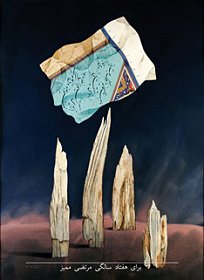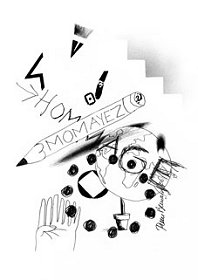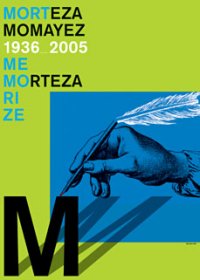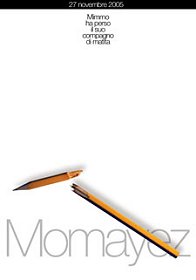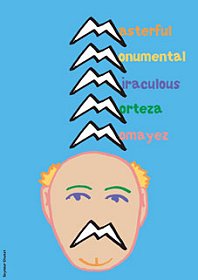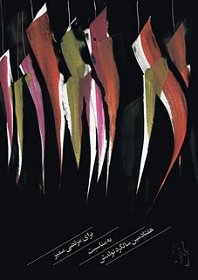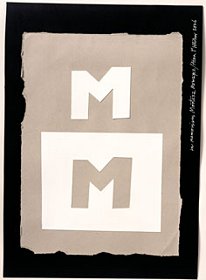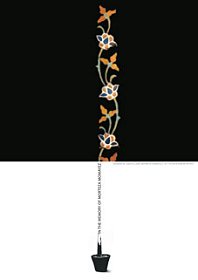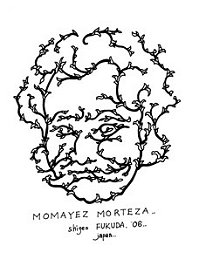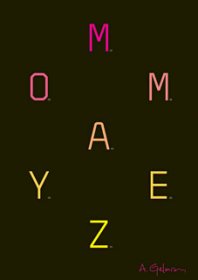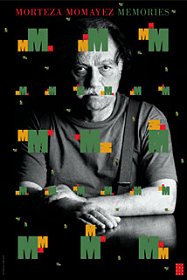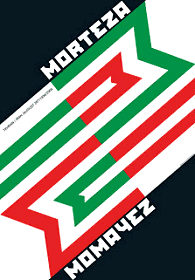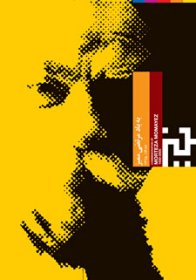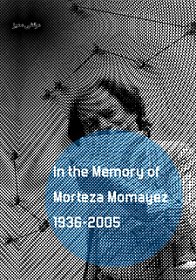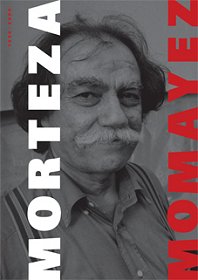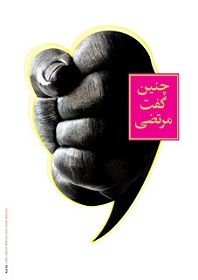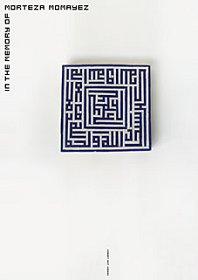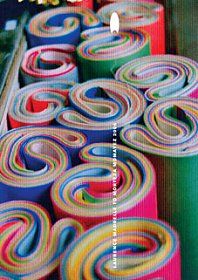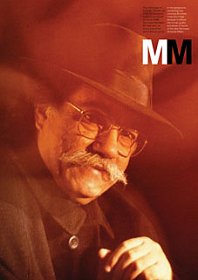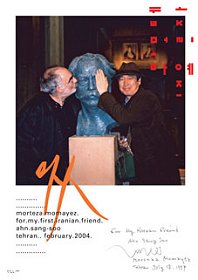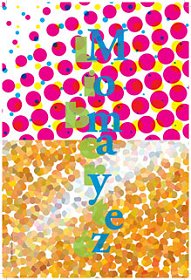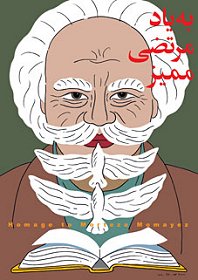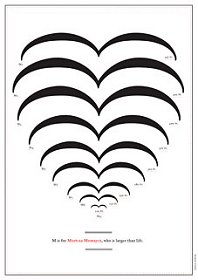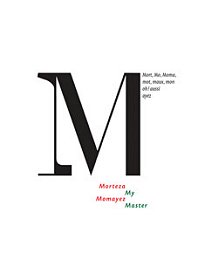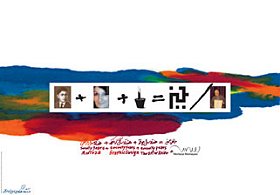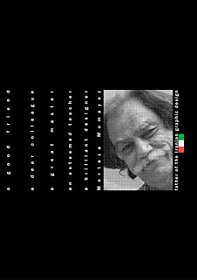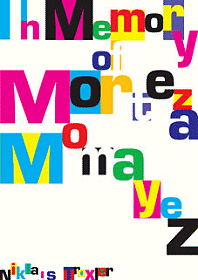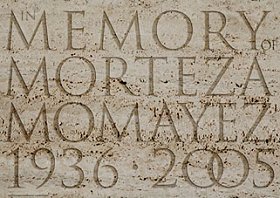Forty one Posters by Forty one International Graphic Designers
In honor of 70th Birth Anniversary of Morteza Momayez
By Majid Abbasi, Curator of exhibition and member of editorial board of Neshan Magazine
When we lost Momayez, we at the editorial board of Neshan magazine decided not to write anything about his death. Instead, we decided to work for his survival, to feast his 70th birthday and the best thing to do was to organize an art exhibition in his memory.
We called his friends from Iran and from around the world for a reunion with Morteza Momayez. We sent letters to all his friends in Japan, Turkey, Korea, Greece, Poland, Germany, France, Columbia, England, Switzerland, United States, Italy and Australia.
All his friends shook our hands and replied with kindness, affection and love. Some couldn't make it or did not receive our letters.
Ralph Schraivogel from Switzerland wrote a loving letter and, remembering his visit of Morteza Momayez in Tehran, apologized that he couldn't send his work to the Exhibition on time due to his travel to Japan. Gabriel, Holger Matthies's wife explained on behalf of her husband that he was sick and on travel and therefore could not take part in the Exhibition. Wolfgang Weingart, tired of long years of work and teaching, excused himself.
However, many friends of Momayez responded positively and sent their works to the Exhibition. Bruno Monguzzi did not create any work but wrote a letter and remarked that Morteza is not among us and cannot see our works, but he understands my words. Rosmarie Tissi who could hardly see after an eye surgery, sent us her work. Alex Jordan made a sketch of Morteza Momayez as he remembered him. Uwe Loesch incorporated in his work the gift Momayez had bought for him in Isfahan. With an indescribable love, Alain Le Quernec wrote that few people have been influential in his life and undoubtedly Morteza has been one of them. Ebrahim Haghighi changed his work three times to make sure what he offered was suited Morteza and Aydin Aghdashloo dedicated one of his newest works to his memory. Abbas Kiarostami designed a white blank frame in utmost simplicity and Mohammad Ehsai designed, not one but two, calligraphy works with his emotional and powerful hands. Sadik Karamustafa who had organized an event in commemoration of Morteza Momayez this year in Istanbul, wrote his name on his heart. Dimitris Arvanatis, Bruno Oldani, Melk Imboden, Ben Bos, Pierre Bernard, Shigeo Fukuda, Milton Glaser and others also created works for Momayez and for display in this Exhibition with love and affection.
-Editorial Board, Neshan Magazine
Intelligence of heart, and altruism
By Alain Le Quernec
In the early sixties the Swiss graphic magazine 'Graphis' was nearly the only graphic design magazine or for the least the most famous one. Created by Walter Herdeg during World War 2, it soon became the reference for graphic designers all around the world. I suppose that, as many of us, the young Morteza Momayez discovered in 'Graphis' the new the modern tendencies like the Swiss design or the Polish poster, and this publication encouraged him to develop his art and realize himself. Morteza Momayez was Iranian and in the fifties Iran, despite a deep and rich tradition of illustration and calligraphy that was considered as an art, did not pay attention to graphic design.
With his vision of modernity, Morteza understood at once how important it was that graphic design had to be developed in this country. He knew the value from what he had learnt in Europe and especially when he studied at the French school 'Ecole Supérieure des Arts Décoratifs' in Paris...
As everyone, the young Morteza was under the various - sometimes contradictory - and attractive influences of the Swiss design on one side, and the Polish poster on the other side. The one for the perfectionism, the rigor of its typography, and the other - at the opposite - for the freedom of its creativity 'beyond the rules', for the freshness of its expressionism...To be under influence does not mean to duplicate the model, and to make a pale copy of the original... that is not in the Iranian mentality... and certainly not in Morteza's mentality.
I read that he had a deep respect for the Japanese graphic design, and I can understand that easily. Japan entered the modernity in industrial and technologic fields to become one of the leaders, keeping in the same time its culture and tradition... graphic design being no exception. In time of uniformed world design, the Japanese design keeps its personality, its true own style.
And so did Morteza in Iran. He tried to respect the rules of Swiss design, or to develop the inventions like in Polish posters, but first of all his works were Iranian, they belonged to his own culture.
Very soon his works attracted attention on the little planet of graphic designers, because his works were new, different. And yet they were part of the world of Iranian typography, where almost nothing, as far as I know, had been done in the field of graphic design. So Morteza was invited to be member of the AGI, the Alliance Graphique Internationale, a very small, select international club of graphic designers, fighting for the excellence of their art. He was the first Iranian member. Then came the Islamic revolution and moreover the terrible eight years' war against Iraq. A war that isolated Iran from the rest of the world... As everyone else I believed that the Iranian graphic design movement would have disappeared...
When I was invited in Iran in 2001, it was for me a great surprise to discover how alive, how modern, how creative and how structured it was...I actually discovered a society of graphic designers that has the fighting spirit of making good design, innovating, open to new tendencies, aware and curious of everything... I do not know many countries where such an organization exists, with such efficiency. Now there are three generations of Iranian designers, all of them considering their work more like an art than the dress of advertising. And that was due to the effort of Morteza during these hard times.
Since the beginning Morteza was not alone, but more than others, he was an organizer, federating the energies of all the designers, animated by the same spirit of creation, and therefore giving more power to their action. From the beginning, he knew how important education was, and to make graphic design become something more than a low-rated section of the art schools, get it recognized as a real art department in the University and make the best designers to be the professors.
The result of this action is obvious. Iranian graphic design is now one of the most dynamic, one of the most original, one of the most awarded on the international scene by people who felt guilty of not having discovered it earlier...
Nothing is eternal. Like flowers, artistic movements bloom, develop and disappear again. C'est la vie… the Polish poster movement has gone down…. But very seldom such movements are due to one personality, as it was in Iran with Morteza. Who knows how long this Iranian movement will last? I believe it will continue for a long time, because it is well structured, because its members are young and talented, and they are the heritors of Morteza's example.
I pay my respect to Morteza Momayez, the artist, the great graphic designer who managed to introduce modern graphic design in Iran.
I pay my respect to Morteza Momayez, the professor and the federator who managed graphic design to become a real department at the University.
But above all I pay my respect to Morteza Momayez, the human being, who beyond his personal artistic talents has been able to build this structure that makes Iranian graphic design one of the most interesting in the world, thanks also to the intelligence of his heart, his humanism and his altruism. Very seldom one person attracted so much my respect and my admiration. It was an honor to encounter him.
Morteza Momayez: a beautiful personality
By Ben Bos
Getting older has its disadvantages. But one thing is a real benefit: you have built up plenty of insight in the character of most men. For me, that meant that I 'fell in love' with Morteza Momayez at first sight. His radiant, charming personality looked like a beautiful open book. The way he looked into your eyes marked him as warm, friendly, open, inviting you to approach him, to speak with him.
Remarkably I am not sure when I first met him. But surely our AGI congress in Helsinki was the time to remember forever. He was there, amidst his Iranian 'designers family', as the patriarch, the leader, the professor, the mediator. Inviting us all to come, make acquaintance of his companions, to exchange our designs, to enjoy being there.
We, my wife Elly and I, were close to him and saw him last on the small dancing floor - at the closing evening of AGI Helsinki 2003.
Enjoying his still unbroken vitality of the younger man nearing his seventies. He came into the Alliance Graphique Internationale in 1977, one year ahead of me. I do not have the good habit to write the date in a book people sent me. He mailed me his poster book that is showing his works between 1959 and 1985.
He organized the posters neatly in chronological order. It offers a good insight in the various techniques he applied over the years. Drawing, painting, working with blownup graphic screens, scratching, copying, playing around with photography. Turning halftones into harsh black & white. I liked that work. There were a lot of posters that had to do with movies. There were many hands in his visuals, sometimes even with too many fingers. In the text he made clear that thecodes of conduct in his country often ask for symbolic, almost hidden visualizations, when messages go from a good source to an
intelligent spectator.
Morteza was a true kind of pioneer, although in writing messages his country Iran has one of the longest traditions in the world. Morteza enriched the culture of the land with new ways of visual expression, where paintings and drawings come together with the traditional lettering and quite often their translated Western-style of typography. And he was the teacher, who spread the message. Our Breton friend Alain Le Quernec told me that Morteza admired the Japanese, who also cherish an ancient culture and yet are frontrunners in modern graphic design.
His too early death was a severe blow for everybody, including the international design society. He is remembered with gratitude. When I was asked to join a project of making a poster for the 70th birthday that 'came too early', I looked at his book once more and saw the many hands on his posters and book covers. I decided to join him, shaking a hand.
Letter from Bruno Monguzzi
Caro Morteza,
My grandmother, when I was a child, told me that dead people cannot see anymore but can read every language.
Last year, when you left - busy as you were in very private matters - you forgot
to leave your new address.
I therefore write to Majid because he said he would publish these words in your
magazine.
I just wanted to say that I miss you a bit.
I miss your true smile, hidden under the huge vault of your moustache and
revealed by your clear eyes.
I miss your voice singing - along with Afsaneh's gentle swinging - the songs of
your nation.
But I have your work, to always remind the true essence of things.
Arrivederci Morteza, because my grandmother, when I was a child, told me that when you lose someone it is not forever.
Forever you'll meet again.
A strong hug
Bruno
Caro Morteza,
mia nonna, quand'ero bambino, mi aveva raccontato che i morti non vedono più. Ma che leggono qualsiasi lingua.
Quando l'anno scorso sei partito - occupato in ineludibili private faccende - ti
sei scordato di lasciare il tuo nuovo indirizzo.
Allora scrivo a Majid, perchè mi ha assicurato che pubblicherà queste righe
sulla tua rivista.
Volevo dirti che mi manchi un pò.
Mi manca il tuo sorriso nascosto sotto l'immensa volta dei tuoi baffi e svelato
dai tuoi occhi ridenti.
Mi manca la tua voce cantare - nel dolce dondolare di Afsaneh - i canti della
tua gente.
Mi restano i tuoi lavori, per richiamarmi sempre all'essenza delle cose.
Arrivederci Morteza, perchè mia nonna, quand'ero bambino, mi aveva raccontato che quando si perde qualcuno non è per sempre.
Per sempre ci si ritrova.
Ti abbraccio
Bruno
A long way
By Rene Wanner
When Morteza Momayez was born, 70 years ago, there were no posters in Persia, as we know them today. The first theater posters, with text only, had been pasted to the walls of Tehran in 1926. In 1928, two Armenian immigrants from Russia started to paint movie posters that were placed in front of the cinemas. In 1935, the chief of police argued with the prime minister about the proper Persian word for "advertisement". In Tehran, there were few telephones, no airplane tickets, no television, no computers,
no Internet, no graphic designers.
Now, almost a year after Morteza Momayez' death, our world has changed a lot. I suddenly became aware of how far graphic design in Iran has come when a notable Iranian poster artist won a prize at an international poster biennial this summer, and Guy Schockaert, a former ICOGRADA president, tried to call his studio in Tehran while the award ceremony was still going on. He did not get through because the artist was in the Far East opening a personal exhibition. The little incident made me think of Morteza Momayez, and the role he played in paving the way from there to here.
Another personal memory
|
